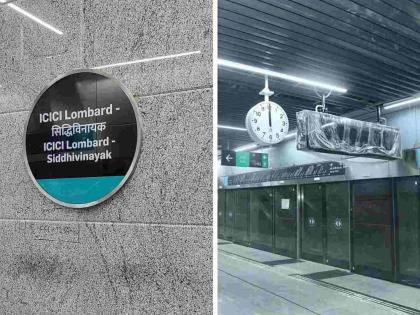Mumbai Metro 3: City’s Only Aqua Line to Ease Travel Across Commercial Hubs, Religious Landmarks & Cultural Sites – Key Facts Here
By Lokmat Times Desk | Updated: September 18, 2025 12:59 IST2025-09-18T12:58:05+5:302025-09-18T12:59:20+5:30
Mumbai’s Metro Line 3, also known as the Colaba-Bandra-SEEPZ corridor, is nearing completion, with the Worli to Cuffe Parade ...

Mumbai Metro 3: City’s Only Aqua Line to Ease Travel Across Commercial Hubs, Religious Landmarks & Cultural Sites – Key Facts Here
Mumbai’s Metro Line 3, also known as the Colaba-Bandra-SEEPZ corridor, is nearing completion, with the Worli to Cuffe Parade stretch set for inauguration by Prime Minister Narendra Modi on September 30, 2025. Once fully functional, the underground route will connect major commercial hubs, cultural landmarks, and religious sites across the city. For lakhs of daily commuters, this project promises shorter travel times and a reliable alternative to road traffic. Here are some key features and facts about this metro route:
1. A 33.5-km-long Long Underground Corridor
Stretching 33.5 kilometres from Cuffe Parade in South Mumbai to Aarey in the north, the Aqua Line will cover 27 stations in total. The project is expected to ease traffic congestion on busy arterial roads and reduce the load on Mumbai’s Western and Central Railway networks. Designed to provide seamless connectivity across regions, the Aqua Line will strengthen Mumbai’s transport backbone, helping commuters travel quickly, comfortably, and more efficiently than before.
2. Direct Link to Business and Industrial Hubs
One of the biggest highlights of Metro 3 is its connectivity to major business districts. The route links Cuffe Parade, Churchgate, and Fort to Bandra-Kurla Complex (BKC), the city’s growing financial centre. It also extends to SEEPZ, home to IT companies and export units. For office-goers working in BKC, Fort, or Kalbadevi but living in the suburbs, this line will reduce the struggle of daily traffic jams and provide a faster, more dependable commute.
Also Read: Mumbai Businessman Jumps Off Bandra-Worli Sea Link, Body Found Near Juhu
3. Easy Access to Religious Destinations
Beyond business, Metro 3 enhances access to some of Mumbai’s most visited religious landmarks. The line connects directly to Siddhivinayak Temple in Prabhadevi, Haji Ali Dargah in Mahalaxmi, and Mount Mary Basilica in Bandra. Devotees will find it easier to reach these destinations, especially during festivals like Navratri. Areas such as Worli, Kalbadevi, and Girgaon are expected to witness high passenger traffic, highlighting the corridor’s role in balancing urban mobility with cultural and spiritual needs.
4. Boost for Cultural and Tourist Landmarks
Metro 3 will also strengthen Mumbai’s reputation as a cultural hub. The line passes near major attractions like the National Centre for the Performing Arts (NCPA) and the iconic Gateway of India, making these venues more accessible to locals and tourists alike. Improved access is expected to increase footfall at these cultural and heritage sites, boosting the city’s tourism industry while offering residents a convenient way to experience Mumbai’s historic and artistic charm.
5. Connecting Education and Healthcare Facilities
Educational institutions and hospitals are also set to benefit from the Aqua Line. The metro will link commuters to reputed colleges like St. Xavier’s, Government Law College, and the University of Mumbai’s Kalina campus. At the same time, hospitals such as Hinduja, Nair, and Wockhardt will be within easier reach. Students, patients, and healthcare professionals can expect shorter and more comfortable journeys, making Metro 3 a critical lifeline for essential services in the city.
6. Modern Infrastructure and Daily Ridership
According to the Mumbai Metro Rail Corporation (MMRC), Metro 3 is designed to handle a daily ridership of more than 6.5 lakh passengers. The line will feature air-conditioned trains, advanced safety systems, and smooth interchanges with other metro corridors for better connectivity. By blending modern technology with convenience, the Aqua Line is poised to redefine the commuting experience, offering Mumbaikars a safe, efficient, and sustainable mode of public transportation.
7. A New Era for Mumbai’s Public Transport
Once inaugurated, Metro Line 3 will revolutionise urban mobility in Mumbai by combining commerce, culture, education, healthcare, and faith into one seamless corridor. It will not only reduce road congestion and pollution but also significantly improve the quality of life for millions of residents. The Aqua Line is expected to emerge as the city’s most crucial transport link, reinforcing Mumbai’s position as India’s commercial capital while providing commuters with a smarter, faster way to travel.
Open in app